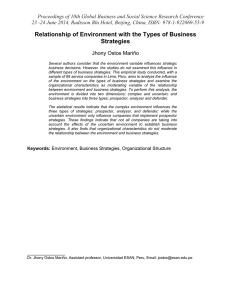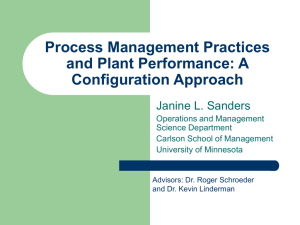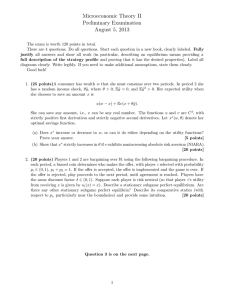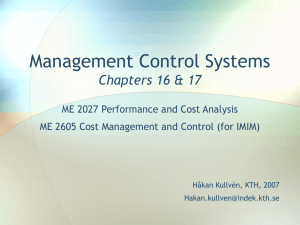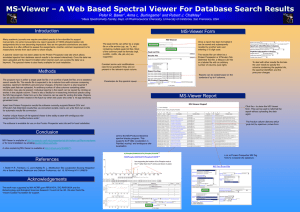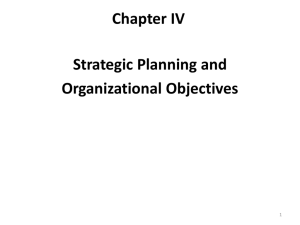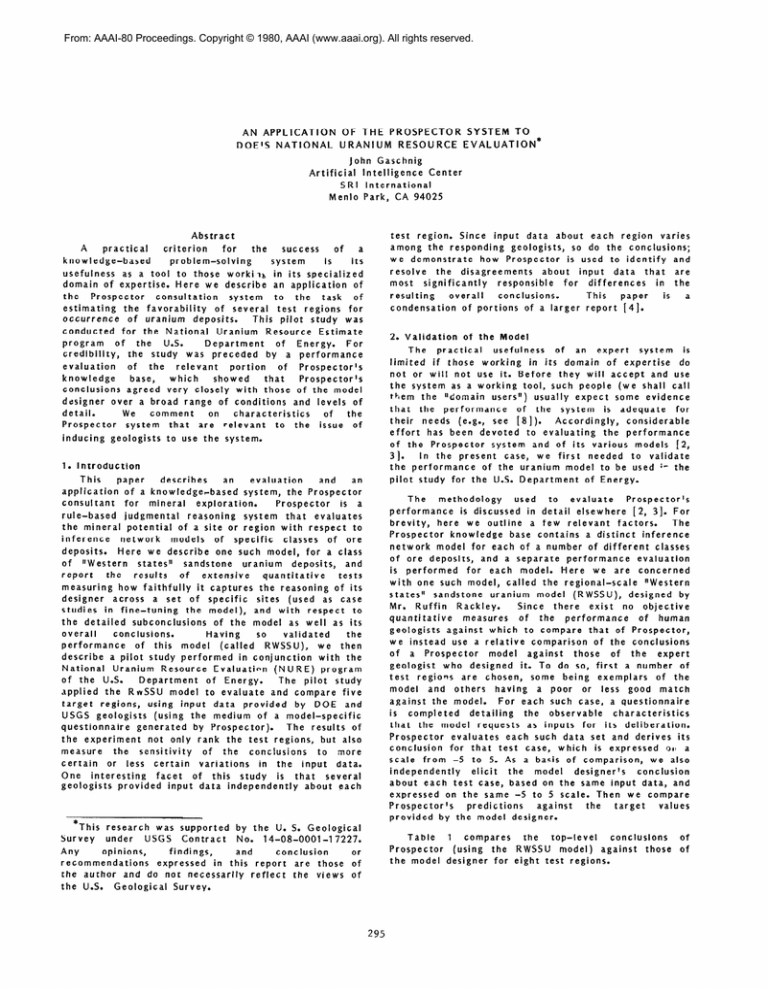
From: AAAI-80 Proceedings. Copyright © 1980, AAAI (www.aaai.org). All rights reserved.
AN
DOE’S
APPLICATION
OF
NATIONAL
THE
PROSPECTOR
URANIUM
RESOURCE
SYSTEM
TO
EVALUATION*
John Gaschnig
Intelligence
Center
SRI
International
Menlo
Park,
CA 94025
Artificial
test
region.
Since
input
data
about
each
region
varies
among
the responding
geologists,
so do the conclusions;
we demonstrate
how Prospector
is used to identify
and
resolve
the
disagreements
about
input
data
that
are
most
significantly
responsible
for
differences
in
the
Abstract
A
practical
criterion
for
the
success
of
a
knowledge-based
problem-solving
its
system
is
usefulness
as a tool
to those
workilb
in its specialized
domain
of expertise.
Here
we describe
an application
of
the
Prospector
consultation
system
to
the
task
of
estimating
the
favorability
of several
test
regions
for
occurrence
of uranium
deposits.
This
pilot
study
was
conducted
for
the National
Uranium
Resource
Estimate
program
of
the
U.S.
Department
of
Energy.
For
credibility,
the
study
was preceded
by a performance
evaluation
of
the
relevant
portion
of
Prospector’s
knowledge
base,
which
showed
that
Prospector’s
conclusions
agreed
very
closely
with
those
of the model
designer
over
a broad
range
of conditions
and levels
of
detail.
We
comment
on
characteristics
of
the
Prospector
system
that
are
relevant
to
the
issue
of
inducing
1.
geologists
to
use
the
resulting
condensation
2.
system.
This
describes
an
evaluation
and
an
paper
application
of a knowledgerbased
system,
the Prospector
consultant
for
mineral
exploration.
Prospector
is a
rule-based
judgmental
reasoning
system
that
evaluates
the mineral
potential
of a site or region
with
respect
to
inference
network
models
of
specific
classes
of
ore
deposits.
Here
we describe
one such model,
for a class
of
“Western
statesIr
sandstone
uranium
deposits,
and
report
the
results
of
extensive
quantitative
tests
measuring
how faithfully
it captures
the reasoning
of its
designer
across
a set
of
specific
sites
(used
as case
studies
in fine-tuning
the
model),
and with
respect
to
the
detailed
subconclusions
of the
model
as well
as its
overall
conclusions.
Having
so
validated
the
performance
of
this
model
(called
RWSSU),
we
then
describe
a pilot
study
performed
in conjunction
with
the
National
Uranium
Resource
Evaluation
(NURE)
program
of the
U.S.
Department
of Energy.
The
pilot
study
applied
the
RwSSU
model
to evaluate
and compare
five
target
regions,
using
input
data
provided
by DOE
and
USGS geologists
(using
the
medium
of a model-specific
questionnaire
generated
by Prospector).
The results
of
the
experiment
not only
rank
the test
regions,
but also
measure
the
sensitivity
of
the
conctusions
to
more
supported
Contract
model
against
the
is
a
Model
and
the
others
model.
having
a
For each
poor
such
or
less
good
match
case,
a questionnaire
is
completed
detailing
the
observable
characteristics
that
the
model
requests
as inputs
for
its
deliberation.
Prospector
evaluates
each such data set and derives
its
conclusion
for
that
test
case,
which
is expressed
081 a
scale
from
-5 to 5. As a basis of comparison,
we also
independently
elicit
the
model
designer’s
conclusion
about
each
test
case, based on the same input
data,
and
expressed
on the same -5 to 5 scale.
Then
we compare
Prospector’s
predictions
against
the
target
values
provided
by the model
designer.
by the U. S. Geological
No.
14-08-0001-l
7227.
opinions,
findings,
and
conclusion
Any
recommendations
expressed
in this
report
are those
the
author
and do not necessarily
reflect
the
views
the U.S.
Geological
Survey.
of
paper
[4].
The
methodology
used
to
evaluate
Prospector’s
performance
is discussed
in detail
elsewhere
[2, 31. For
brevity,
here
we outline
a few
relevant
factors.
The
base contains
a distinct
inference
Prospector
knowledge
network
model
for each of a number
of different
classes
of ore deposits,
and a separate
performance
evaluation
is performed
for
each
model.
Here
we are
concerned
with
one such model,
called
the regional-scale
“Western
states”
sandstone
uranium
model
(RWSSU),
designed
by
Mr.
Ruffin
Rackley.
Since
there
exist
no objective
quantitative
measures
of
the
performance
of
human
geologists
against
which
to compare
that
of Prospector,
we instead
use a relative
comparison
of the conclusions
of
a Prospector
model
against
those
of
the
expert
geologist
who
designed
it.
To do so, first
a number
of
test
regions
are
chosen,
some
being
exemplars
of the
certain
or
less
certain
variations
in the
input
data.
One
interesting
facet
of
this
study
is
that
several
geologists
provided
input
data
independently
about
each
research
was
under
USGS
Validation
This
report
The
practical
usefulness
of
an
expert
system
is
limited
if those
working
in its domain
of expertise
do
not or will
not use it. Before
they
will
accept
and use
the system
as a working
tool,
such people
(we shall
call
them
the
“domain
users”)
usually
expect
some evidence
that
the
performance
of
the
system
is adequate
for
their
needs
(e.g.,
see [8]).
Accordingly,
considerable
effort
has been
devoted
to evaluating
the
performance
of the
Prospector
system
and of its various
models
[2,
In the
present
case,
we first
needed
to validate
31.
the performance
of the uranium
model
to be used r- the
pilot
study
for the U.S. Department
of Energy.
Introduction
*This
Survey
overall
conclusions.
of portions
of a larger
Table
Prospector
the model
or
of
of
295
1
compares
(using
the
designer
for
the
top-level
conclusions
RWSSU
model)
against
those
eight
test regions.
of
of
Table
1.
Comparison
for
Test
of
Eight
RWSSU model
Test
with
Designer
Cases
Region
Designer’s
Target
--------------------------------------------------
Prospector
Score
Di fference
Black
Hi Ils
3.50
Crooks
Gap
4.70
Gas Hills
4.90
Shirley
Basin
4.95
Ambros i a Lake
5.00
Powder
River
4.40
Fox Hi I I s
1.50
Oi I Mountain
1.70
-------------------------------------------------
4.33
4.26
4.37
4.13
4.39
4.40
2.17
3.32
-0.83
0.44
0.53
0.82
0.61
0.00
-0.67
-1.62
Average:
0.69
3.
Besides
the overall
conclusions
reported
above,
quite
detailed
information
about
Prospector’s
conclusions
was
collected
for
each
test
One
feature
of
the
case.
Prospector
system
is
the
ability
to
explain
its
conclusions
at any desired
level
of detail.
In its normal
interactive
mode,
the user
can interrogate
Prospector’s
conclusions
by
indicating
which
conclusions
or
subconclusions
he wishes
to see more information
about.
The
same
sort
of information
is presented
in Table
2
(using
the Gas Hills
region
as an example),
in the form
of Prospector’s
overall
evaluation,
the major
conclusions
on
which
the
overall
evaluation
is based,
and
the
subconclusions
that
support
each
major
conclusion.
For
brevity,
each
section
of the
RWSSU
model
represented
in Table
2 is identified
by its symbolic
name,
which
is
indented
to
show
its
place
in
the
hierarchy
of
the
model.
For
comparison,
we
first
elicited
from
the
model
designer
his target
values
for each section
of the
model
listed
in Table
2; these
values
are
included
in
Table
2.
2.
Detailed
Designer
Comparison
of
for
Gas Hills
RWSSU Model
Designer’s
Target
------------------------------------------------
Prospector
Score
RWSSU
FTRC
4.37
4.64
4.50
4.95
5.00
4.88
4.68
4.68
4.90
4.80
4.50
5.00
4.80
4.80
4.90
4.90
TECTON
AHR
FAVHOST
S EDTECT
FAVSED
FLUVSED
KAlti’lESE:)
-3.54
-2.03
AEOLSED
-2.50
4.95
5.00
4.00
5.00
-2.10
4.41
4.60
4.77
5.00
FMA
RBZONE
AIZONE
M I NZONE
Average
(Average
only
difference
of absolute
The
data
reaches
=
in Table
essentially
with
Difference
.53
.16
.oo
.05
-. 20
-.08
.22
.22
-1.43
-.40
.54
.40
-.77
lo o
0.36
values)
2
indicate
the
same
its
designer,
but
does
so
for
similar
This
reasons.
Gaschnig
[4]
also
reports
sensitivity
analysis
experiments
showing
the
models
to be rather
stable
in
conclusions:
their
for
the
RWSSU
model,
a
10%
perturbation
in the input
certainties
caused
only
a 1.2%
change
in the output
certainties.
Table
1
indicates
that
the
average
difference
between
the
Prospector
score
and
the
corresponding
target
value
for these
eight
cases is 0.69,
which
is 6.9%
of the -5 to 5 scale.
Table
as
detailed
comparison
was repeated
for each of the eight
resulting
in
112
distinct
comparisons
between
cases,
Prospector’s
prediction
and designer’s
target
value
(i.e.,
The
8 test
regions
times
14 sections
of the
model).
average
difference
between
Prospector’s
score
and
designer’s
target
value
over
these
112 cases
was 0.70,
or 7.0% of our standard
lo-point
scale.**
that
Prospector
not
numerical
conclusions
Results
of
the
NURE
Pilot
Study
Having
established
the
credibility
of
the
RWSSU
test
results
just
discussed,
we
then
model
by
the
undertook
an evaluation
of five
test
regions
selected
by
For this
purpose
USGS and
the Department
of Energy.
DOE geologists
completed
questionnaires
for this model.
As a sensitivity
test,
several
geologists
independently
For
completed
questionnaires
for
each
test
region.
R. Rackley,
also
designer,
the
model
comparison,
The
completed
questionnaires
for the five
test
regions.
overall
results
are
reported
abbreviations
M.H.,
P.B., MO.,
test
regions,
names
of
the
Pumpkin
Buttes,
Moorcroft,
White
River,
respectively.
Table
3.
Geologist
Overall
A
in Table
3, in which
N.G.,
and W.R. denote
namely
Monument
Northwest
Gillette,
Conclusions
B
C
for
D
Five
the
the
Hill,
and
Test
Regions
USGS Rackley
team
data
Range
-----------------------------------------------M.H.
P.B.
MO.
N.G.
W.R.
4.17
4.20
3.32
3.30
3.97
4.19
3.92
3.64
3.88
0.10
0.13
4.40
4.40
4.00
3.42
0.01
1.08
1.10
0.12
3.54
0.12
The
results
in Table
3 indicate
that
the
Monument
and Moorcroft
regions
are
very
Hill,
Pumpkin
Buttes,
favorable,
and about
equally
favorable,
for
occurrence
uranium
deposits.
sandstone
“Western
States”
of
Northwest
Gillette
is scored
as moderately
favorable,
whereas
White
River
is neutral
(balanced
positive
and
negative
indicators).
different
has
had
Note
that
each
respondent
in
terms
of
both
regions,
to
the
target
exposure
first-hand,
on-site
experience
and familiarity
with
field
These
differences
in
data
reported
in the
literature.
the
reflected
in
their
answers
on
experience
are
Since
different
inputs
yield
different
questionnaires.
in
the
one
would
expect
a
spread
conclusions,
certainties
input
in
Inspection
about
each region,
reflecting
the
various
by
the
data
provided
of Table
3 reveals,
however,
that
differences
geologists.
the scores
derived
from
same region
Northwest
different
agree
Gillette
geologists’
rather
(see
input
closely
for
the
column
data
about
the
special
characteristics
the
case
of economic
geologists
to
disagree
each region
except
labeled
IrRange”).
observations
These
generally
close
agreements
reflect
the
capability
many
diverse
synthesize
models
to
of
Prospector
factors,
mechanically
ascertaining
general
commonalities
occasional
being
unduly
distracted
by
without
various
Prospector
In cases such as Northwest
Gillette
in which
a large
difference
in conclusions
occurs,
it is easy to trace
the
source
of the disagreement
by comparing
the individual
model
sections
of
the
different
for
conclusions
(representing
different
geological
subconclusions),
as in
Table
4.
4.
Comparison
of
About
Northwest
Geologist
C
Detailed
Conclusions
Gi I lette
D
Rackley
data
Avg.
3.42
4.63
4.50
4.94
5.00
4.78
4.79
4.79
.02
-3.23
1.33
4.73
0.00
2.59
3.56
4.37
4.63
3.64
5.00
4.69
2.92
2.92
-.41
-3.44
2.18
4.55
-0.30
1.94
----------------------------------------RWSSU
FTRC
TECTCN
AHR
FAVHQST
S EDTECT
FAVSED
FLUVSED
MAR I NESED
AEOLSED
FMA
RBZQNE
AIZQNE
M I NZQNE
Inspection
agree
fairly
.lO
4.67
4.90
4.95
5.00
4.98
.04
.04
-4.60
-4.99
.27
4.10
-3.29
.41
of Table
closely
for
3.66
3.80
4.50
1.03
5.00
4.33
3.92
3.92
3.34
-2.10
2.45
4.83
2.40
2.82
4 reveals
the FTRC
2.
that
the
conclusions
section
of the model,
Conference
1979.
also
been
applied
to several
other
One
evaluated
several
regions
on the
practical
tasks.
Alaskan
Peninsula
for
uranium
potential
[l 1, as one of
the
bases
for
deciding
their
ultimate
disposition
(e.g.,
exploitation).
commercial
wilderness
status
versus
concc’rnad
with
measuring
app!iccztian
das
Another
of a geological
results
[ 71.
Gaschnig,
J. G.,
“Development
of
Uranium
Exploration
Models
for
the
Prospector
Consultant
System,”
SRI
Project
7856,
Artificial
Intelligence
Center,
SRI
International,
Menlo
Park,
California,
March
1980.
5.
National
Uranium
Resource
Report,
U.S.
Department
GJO-111(79),
Grand
Junction,
6.
work
illustrates
practical
use
Evaluation,
of
Energy,
Colorado,
June
Interim
Report
1979.
Roach,
C. H.,
“Overview
of
NURE
Year
1979,”
Preprint
of Proceedings
Industry
Seminar,
U. S.
Department
Grand
Junction,
Colorado,
October
Progress
Fiscal
of the Uranium
of
Energy,
16-17,
1979.
map,
Discussion
We have
measured
Prospector’s
expertise
explicitly
and
presented
a practical
application
to
a national
project,
demonstrating
in particular
how the Prospector
approach
deals
effectively
with
the
variabilities
and
resource
task
of
inherent
in
the
uncertainties
This
actual
on
“Preliminary
Performance
Analysis
of
Consultant
System
for
Mineral
Proc.
Sixth
International
Joint
Artificial
Intelligence,
Tokyo,
August
4.
7.
Shapiro,
C.,
and W. Watson,
“An
the
Value
of
Geologic
Maps,”
Report,
Director’s
Office,
U.S.
Reston,
Virginia,
1979.
8.
Yu,
V.L.,
et al.,
“Evaluating
Computer-Based
Consultant,”
Project
Memo
H PP-78-17,
Science,
Stanford
University,
4.
assessment.
intenderr
for
in
Duda,
R.O.,
P.E.
Hart,
P. Barrett,
J. Gaschnig,
K. t\onolige,
R. Reboh,
and J. Slocum,
“Development
of
the
Prospector
Consultation
System
for
Mineral
Exploration,”
Final
Report,
SRI
Projects
5821
and
6415,
Artificial
Intelligence
Center,
SRI
International,
Menlo
Park,
California,
October
1978.
3. Gaschnig,
J. G.,
the
Prospector
Exploration,”
has
the economic
value
statistically
significant
of
1. Cox,
D. P.,
D. E.
Detra,
and
R. L.
Detterman,
“Mineral
Resources
of
the
Chignik
and
Sutwick
Island
Quadrangles,
Alaska,”
U.S. Geological
Survey
Map MF-1053K,
1980 in press.
source
of overall
disagreement
to a few
key
questions
These
can then
about
rhich
the respondents
disagreed.
be resolved
by the respondents
without
the
need to be
their
in
disagreements
with
other
concerned
questionnaire
inputs
that
did not significantly
affect
the
overall
conclusions.
quantitatively
resulting
in
a given
site.
Accordingly,
the
use
of
sensitivity
analysis
is
stressed
bound
the
impact
of such
disagreements
References
and
less
closely
for
the
FAVSED
and
FMA
sections.
Tracing
the
differences
deeper,
one
sees
that
of the
three
factors
on which
FMA
depends,
there
is fairly
good
agreement
about
RBZONE,
but larger
differences
in the cases of the AIZONE
and MINZONE
sections.
In
such
a detailed
analysis
can
isolate
the
some
cases,
Prospector
In
field
their
and
to
isolate
their
sources.
In so doing,
we provide
geologists
with
new quantitative
techniques
by which
to
address
an
important
issue,
thus
adding
to
the
attractiveness
of Prospector
as a working
tool.
Other
domains
of expertise
will
have
their
own peculiarities,
which
nust
be accommodated
by
designers
of
expert
systems
for
those
domains.
A more
mundane,
but
nevertheless
important,
example
concerns
the
use of a
questionnaire
as a medium
for
obtaining
input
data
to
Prospector
from
geologists.
Most
geologists
have
little
or no experience
with
computers;
furthermore,
access
to
a
central
computer
from
a
remote
site
may
be
problematic
in practice.
On the
other
hand,
geologists
seem to be quite
comfortable
with
questionnaires.
Our
point
is simply
that
issues
ancillary
to Al usually
have
to
be addressed
to
ensure
the
practical
success
of
knowledge-based
Al systems.
disparities.
Table
at
sorts
to
of the
domain
of expertise.
geology,
it is not
rare
for
to
some
extent
about
that
expert
systems
must accommodate
the
297
Interim
Report
on
Preliminary
Draft
Geological
Survey,
the
Performance
of a
Heuristic
Programming
Dept.
of
Computer
September
1978.

